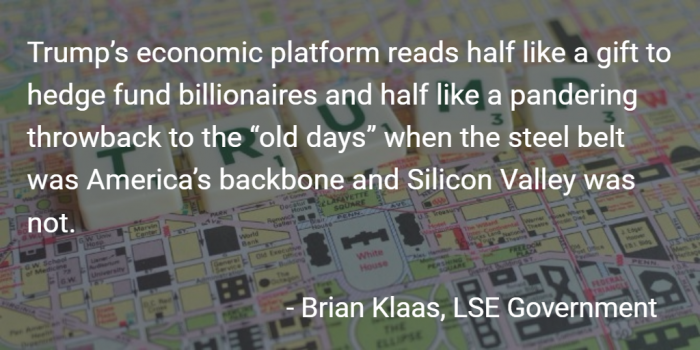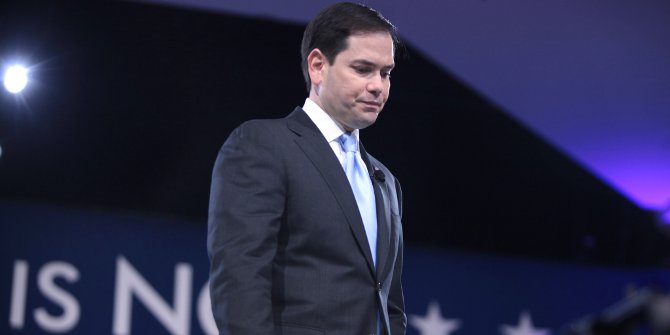 In a speech in Detroit last week, Donald Trump announced his economic policy platform. Brian Klaas writes that Trump’s platform is a bizarre stitching together of economic theories, which aim to appeal to both blue collar workers through protectionism and to the 1% via tax breaks and the further deregulation of Wall Street. He comments that not only are Trump’s proposals in complete conflict with one another in actually promoting economic prosperity, but they would also be a disaster if enacted in terms of lost jobs and growth.
In a speech in Detroit last week, Donald Trump announced his economic policy platform. Brian Klaas writes that Trump’s platform is a bizarre stitching together of economic theories, which aim to appeal to both blue collar workers through protectionism and to the 1% via tax breaks and the further deregulation of Wall Street. He comments that not only are Trump’s proposals in complete conflict with one another in actually promoting economic prosperity, but they would also be a disaster if enacted in terms of lost jobs and growth.
In Mary Shelley’s 1818 novel Frankenstein, a young scientist becomes obsessed with outdated scientific theories in the hopes that he may be able to breathe life into a beautiful new creature. Eventually, his obsession succeeds in creating something new, but the monster is hideous, disfigured, stitched together in unnatural ways.
The same is true of Donald Trump’s strange new economic platform, which stitches together outdated economic theories in a failed effort to win over totally disparate parts of his mishmash of political backers that are part of his unusual political coalition. The bizarre economic creation arose from Trump’s ambition to build an economic platform that offers something to Goldman Sachs executives at the same time as energizing out-of-work auto mechanics who feel victimized by those same Goldman Sachs executives.
In an effort to revive a sinking candidacy, Mr. Trump unveiled the platform in a landmark speech in Detroit on August 8th. Each part of the economic platform was aimed at a different constituency, which can be a savvy political move if done with finesse. But the inclusion of so many disparate economic approaches – pandering to blue-collar plumbers while concurrently proposing major tax breaks to the Rockefellers and Trumps of the world – ended up creating a Frankenstein’s monster of an economic proposal that will ultimately work against its creator’s White House prospects.
The speech was an acute case of economic schizophrenia. At the same time that Trump called for outdated 1950s and 1960s style protectionist populism aimed at benefitting the working class, he also urged America to end the estate tax, a levy that is only imposed on couples who pass on more than $10.9 million in wealth to their family – hardly something an out-of-work coal miner needs to fret about.
Trump then bashed China for failing to play by trade rules. He blamed the decline of prosperity in the American heartland on China’s currency manipulation and their refusal to abide by environmental and labor regulations. Then, in the same breath, he trashed the Trans-Pacific Partnership, which aims to eventually pressure China into ending currency manipulation while forcing them to adopt strict environmental and labor regulations. (While China is not included in the proposed trade agreement for now, it is widely believed that the bloc would be so large as to pressure China to abide by its regulatory framework; Clinton also opposes the TPP, much to President Obama’s chagrin, though it is widely agreed that Clinton’s shift against the TPP is a case of political posturing too).
Trump also called for further deregulation of Wall Street and for other titans of industry as a way to help the economy and bring jobs to blue-collar workers, even though that demographic was hit terribly by the financial crisis made possible by an earlier wave of financial deregulation that amplified systemic risk in banking.
Mr. Trump also co-opted parts of mainstream Republican orthodoxy by calling for massive tax cuts, with the biggest cuts for wealthy Americans. Yet, he has no plan as to how to pay for them other than the fantasy that they will spark so much growth that they will pay for themselves. Non-partisan analyses are clear: that won’t happen. Most assessments estimate that Mr. Trump’s proposals would add more than $10 trillion to the national debt in the next decade if enacted.
Mr. Trump’s economic Frankenstein therefore has two fundamental flaws.
First, the slate of proposals offers a diametrically opposed view of how to promote economic prosperity. Deregulation and supply side tax cuts for the wealthy rely on the belief that free market economics offer the clearest path to growth. But economic protectionism – which has become Trump’s signature populist message – relies on the exact opposite belief: that “protecting” the economy by cutting it off from unbridled competition around the world is the surest path to prosperity. Both extremes – unregulated free trade without protections on the one hand and pure protectionism on the other – are terribly damaging to growth, to workers, and to economic stability. The path forward lies between them, with free trade that softens the rough edges of capitalism with critical regulations and protections. Yet Trump has instead taken the two extremes and attempted to forge a platform where both visions could co-exist. They can’t.

The second problem for Trump’s Frankenstein economics is that his seemingly contradictory proposals would be a disaster if they were enacted. Moody’s economic forecasting conducted a non-partisan analysis of Trump’s proposals and concluded that it would lead to a loss of 3.5 million jobs. It would cost the United States economy trillions of dollars of lost growth. Moody’s is run by Mark Zandi – a former adviser to Republican presidential candidate John McCain – so it can hardly be seen as an organization that’s in the pocket of Hillary Clinton or the Democrats.
There are a few good ideas, of course, in Trump’s proposals. It is admirable, for example, that his policy aims to bring back trillions of dollars that American companies hold overseas to avoid paying the United States’ 35 percent corporate tax. And, he’s right that some outdated bureaucratic red tape is an unnecessary barrier to business growth.
But these ideas are buried within a convoluted hodgepodge approach. There is, however, a rationale to the contorted platform. For Trump to win the White House – something that seems increasingly unlikely by the day – he needs to get his political base to turn out and vote for him. But he needs tycoons to back him too, because American political campaigns devour cash.
This is the reason why Trump’s economic platform reads half like a gift to hedge fund billionaires and half like a pandering throwback to the “old days” when the steel belt was America’s backbone and Silicon Valley was not. These throwback policies are perilous for America’s economic prospects, but also speak to an economic issue that has been neglected for far too long.
Trump’s political success relies most on less educated white males. He has successfully made their plight a critical part of his campaign.
While much of the rest of Mr. Trump’s campaign is based on distortions and fantasy, the focus on the stagnation of wages for this demographic is appropriate. As the now infamous “elephant graph” shows, globalization has left behind lower skill workers in advanced economies like the United States. That group has been neglected by most modern presidential campaigns. Politicians have not done enough to solve the dislocating effects of globalization, including severe job loss in some sectors and heightened inequality across most others.
Without real change to solve those real problems, demagogues like Mr. Trump can become truly dangerous as they create mass support for an inward economic turn away from global trade that would hurt working-class Americans most. In other words, the primary olive branch that Mr. Trump has extended to frustrated blue-collar Americans is little more than a deeply misguided, outdated economic theory that will hurt more than it helps. Protectionism is not the answer. There is little that the United States can do to bring back the boom times of coal mining to places like West Virginia; trying to do so would be both shortsighted and counterproductive. But as more coal miners and those in similar historic industries lose their jobs, American economic policies need to offer something better as an alternative. The same is true across several other sectors that are in their slow but steady death throes. Trump’s economic platform offers no forward-looking solution.
Instead, Trump’s economic proposals aim to breathe life into outdated economic theories, from protectionism to Reaganomics. Thankfully, though, Trump’s economic ideas only rose to life for about 24 hours before his campaign was yet again eclipsed by a series of outlandish statements, from insinuations that “Second Amendment people” could block Hillary Clinton from appointing judges, or that President Obama was the “founder of ISIS,” even as he authorizes daily airstrikes against them. So long as Trump continues to be his own worst enemy with comments like these, his Frankenstein’s monster will be put to bed before it can damage America’s economy.
Featured image credit: Jeff Djevdet, https://speedpropertybuyers.co.uk/(Flickr, CC-BY-2.0)
Please read our comments policy before commenting.
Note: This article gives the views of the author, and not the position of USAPP – American Politics and Policy, nor the London School of Economics.
Shortened URL for this post: http://bit.ly/2aVoOsy
_________________________________
 Brian Klaas – LSE Government
Brian Klaas – LSE Government
Dr. Brian Klaas is a Fellow in Comparative Politics at the LSE. He focuses on democracy, global politics, political violence, voting, and elections. He is the author of the forthcoming book: “The Despot’s Accomplice: How the West is Aiding & Abetting the Decline of Democracy.”






